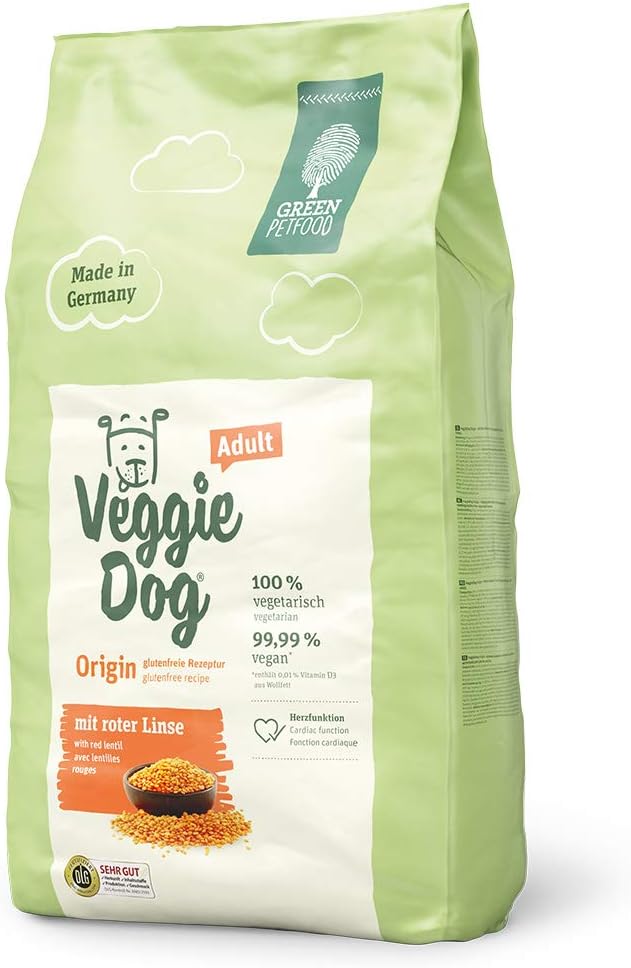My dog, the environmentalist: How to make your pet sustainable
How can the average dog's 950 kg CO₂ footprint be reduced? Practical 7 tried and tested tips for a sustainable dog ownership.

The four-legged friend is hungry and wants some nice toys. We are very happy to give our pets all of this, after all they give us a lot of joy in return.
But if you also want to live sustainably and reduce your impact on the climate, it becomes a little more difficult.
That's why I've put together some important tips for eco-friendly dog ownership. Good luck 🐶🌱
Tip 1: sustainable dog food
Dogs have a major impact on the environment, especially through their diet.
In contrast to cats, dogs can do without animal proteins. It is scientifically proven that dogs have no need for nutrients that only meat can provide. [1] Meat has a much larger footprint and often contributes to the clearing of important forest areas.
Therefore, the most influential tip is a dog food without added meat. Many dogs like vegetables more than you might think.
My dog (called Anton) loves carrots, for example. With a little testing, you'll quickly find out what your dog is crazy about.
Dry food can also be replaced with plant-based dog food. I can recommend this food↗, which is also suitable as a treat.
An environmentally friendly alternative is food made from insects. This way you can give your dog all the nutrients without using meat from cattle, chickens or other animals.
🦗 This dry food↗ is grain-free, hypoallergenic and high in omega-3 fatty acids.
Tip 2: ecological poop bags
One or two plastic bags are the cause of our furry friend's big business. In the long run, of course, that's a lot of plastic consumption. And plastic is not degradable.
There are other ways of keeping dogs sustainably:
- Reuse old plastic bags: For example, I use some bags that have food wrapped in them instead of throwing them away straight away. This gives them a useful second life as poop bags.
- Dog poop bags made of paper/cardboard: There are poop bags made of paper and cardboard.↗. Don't worry, nothing soaks through, and you can pick up the poop better with the cardboard than with a plastic bag.
- Biodegradable poop bags: If you can't completely do without the usual bag, you can at least use bags made from recycled plastic↗ or plastic substitutes, e.g. made from corn starch.
Tip 4: Walk with a lead
Especially in spring, i.e. during the breeding season, it is very important to keep your dog on a lead when out walking.
The natural hunting instinct (which varies depending on the breed of dog) will otherwise tempt the four-legged friends to chase down or even kill nests or birds.
Tip 5: Dog walks without the car
You can often start your walk directly on foot or, if your four-legged friend needs a lot of exercise, you can set off on your bike.
This is good and healthy for you, your dog and, of course, the environment.
Bike mounts for dogs
The dog can even be attached to the bike with a retractable dog leash↗ so that you don't have to hold it while riding.
Smaller dogs can of course also sit in a bicycle basket.
Tip 6: DIY toys and plastic-free alternatives
In addition to food, there are other areas where we can make more sustainable choices for our pets. For example, we can opt for plastic-free toys and make DIY toys from recyclable materials. This reduces the use of plastic and promotes sustainability.
Why is eco-friendly dog ownership relevant?
The increasing number of pets
The number of pets has risen continuously in recent years. For dogs alone, there are almost twice as many today as there were 10 years ago, with over 10 million dogs in 2019. This increasing number of pets also has an impact on the environment.
The CO₂ footprint of dogs
An important factor in the ecological footprint of dogs is their diet.
An average 29-kilogram dog causes around 950 kilograms of CO₂ emissions per year. [2]
This corresponds to a distance of around 2,830 kilometers by car. Most of these emissions are caused by the dog food, but trips to walk the dog also contribute.
Sustainable alternatives to pet food
There are various ways to improve the ecological footprint of pets. One option is to reduce the amount of meat in dog food. BARFing, i.e. feeding raw meat, can provide dogs with higher-quality meat, but this also has an impact on the carbon footprint.
Another option is to switch to a vegan or vegetarian diet for dogs. It is important to consider the dog's nutritional requirements and add supplements if necessary to ensure the dog gets all the nutrients it needs.
The challenges of pet ownership
It is important to note that the ecological footprint of pets is not only dependent on their diet. Other factors such as the use of plastic packaging, the transportation of food and the disposal of dog waste also play a role. It requires conscious action and a willingness to find and implement sustainable alternatives.
Conclusion: Sustainable pet ownership is possible
Keeping pets has an impact on the environment, particularly through their diet. However, there are ways to improve the ecological balance. By reducing the amount of meat in dog food, switching to a vegan or vegetarian diet and using plastic-free toys, we can help to reduce the impact of our pets on the environment. However, it requires conscious action and a willingness to make changes. Because at the end of the day, we don't just want to make our pets happy, we also want to protect our planet.
Sources and more information
- Sustainable dog ownership - how does it work and what are the benefits? | Watson.de
- How environmentally friendly is keeping dogs, cats & co. | BR




Kommentare ()